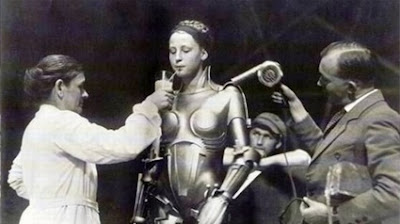What Lies Beneath: The Architecture and Design of Fritz Lang's Metropolis
|
|
||||
What Lies Beneath: The Architecture and Design of Fritz Lang's Metropolis |
||||
|
|
[June 9, 2010] - Newly found footage restores the 1927 film masterpiece, Metropolis, to the closest we will probably ever come to its original form. A must-see movie, at Chicago's Music Box through Thursday, June 17th.. |
|
|||
There is no sprawl visible in the city of Metropolis. Just as the modern architecture of the 1920's was an abstraction of core principles and forms, the city of Fritz Lang's 1927 masterpiece is also an abstraction - and a compaction - of both society and the urban condition in Germany at the time of the film's creation. Functions are piled up and pitched down, from the densely packed skyscrapers above, to the several sub-basements where the industrial underpinnings that keep the paradise going are kept hidden, as are, beneath it, the subterranean city where the untermenschen workers are dumped. 
Rotgang re-creates his great lost love as the film's iconic robot. He will kidnap Maria to reproduce her form on his robot to fabricate a false Maria to mislead the rebelling workers to their doom. At the city's swank nightclub, all pretenses of futurist design are dismissed. The fashions are unabashedly those of the roaring 20's. The false Maria appears, scantily clad as a Theda Bara-like vamp. As her wild (and for us today, unintentionally comical) dancing drives a mob of men in elegant evening dress to sexual frenzy and murder, the cathedral's macabre statutes of the Seven Deadly Sins break free from their niches to replace the bearers carrying her aloft. It's perhaps too easy to read history backwards and see an inevitability, but it's impossible to look at Metropolis without seeing its prophetic cast, one with a much darker ending than Lang was allowed to portray. When Freder, son of Metropolis's master Joh Fredersen, wanders down into the undercity and witnesses an industrial accident that sends workers plummeting to their deaths from the ledges of the great, multi-story control center, with others writhing scalded by steam, he sees the construction morphing into the false God Moloch, with bound, half-naked, shaven-head workers driven up a steep stairway to be pitched into the abyss, conjuring up allusions both backward, to ancient Mayan temples of human sacrifice, and forward, to the horror of the Nazi death camps. The shining temples we build for our cities, sacred or commercial, serve both as reflection of our hopes and cover for our darkest desires. In its contemplation of that dialectic, Metropolis is an essential film. Its images should be see on the big screen to be fully appreciated. It's at the Music Box, through Thursday.
Join a discussion on this story.
© 2010 Lynn Becker All rights reserved.
|
|||||
|
|||||